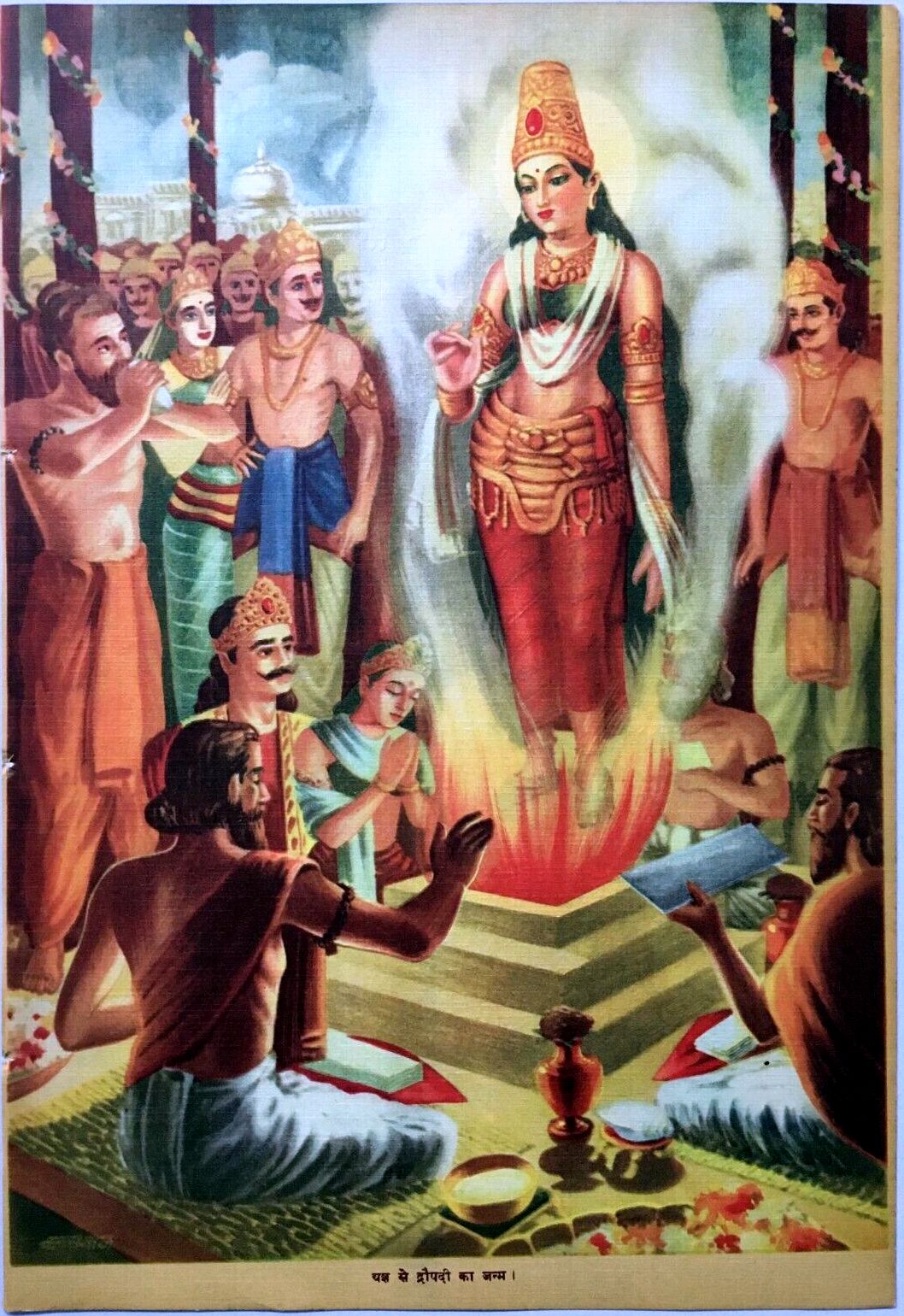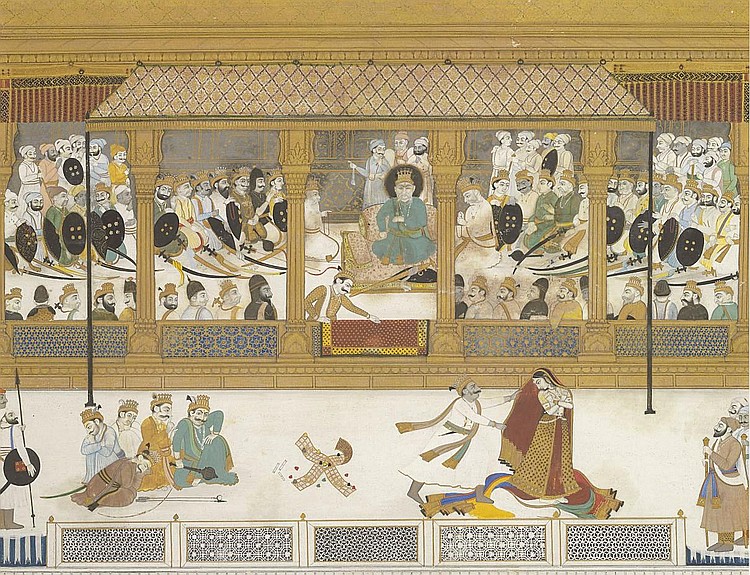|
Dhrishtadyumna
Dhrishtadyumna () is a pivotal character in the ancient Hindu epic ''Mahabharata''. He is the son of DrupadaŌĆöthe king of the Panchala kingdomŌĆöand the brother of DraupadiŌĆöthe wife of the five Pandavas. Dhrishtadyumna is born from a ''yajna'' (fire-sacrifice) organised by Drupada, who wanted a son capable of killing his enemy, Drona. When the Pandava prince ArjunaŌĆödisguised as a ''Brahmana''ŌĆöwon the hand of Draupadi in marriage, Dhrishtadyumna realised his identity. In the Kurukshetra War, Dhrishtadyumna joins the Pandavas, and becomes the supreme commander-in-chief of the Pandava forces. On the fifteenth day of the war, he beheads Drona, fulfilling the mission of his birth. Birth left, A Mughal painting by Bilal Habsi depicting the birth of Dhrishtadyumna. A folio of ''Razmnama'', the Persian translation of the epic Dhishtadyumna, along with Draupadi, is described as an "''ayonija''", one not born from a woman's womb. His birth is narrated in the ''Adi Parva'' o ... [...More Info...] [...Related Items...] OR: [Wikipedia] [Google] [Baidu] |
Bhishma Parva
The Bhishma Parva () ("Book of Bhishma") is the sixth of the eighteen ''parvas'' (books) of the Indian epic ''Mahabharata''. It has 4 sub-books and 124 chapters.Ganguli, K.M. (1883-1896)Bishma Parva in ''The Mahabharata of Krishna-Dwaipayana Vyasa'' (12 Volumes). Calcutta The Bhishma Parva describes the first 10 days of the 18-day Kurukshetra War and its consequences. It recites the story of Bhishma, the commander in chief of the Kauravan armies, who is fatally injured and loses his ability to lead.Dutt, M.N. (1897) ''The Mahabharata (Volume 6): Bhishma Parva''. Calcutta: Elysium Press This book of the ''Mahabharata'' includes the widely studied ''Bhagavad Gita'', sometimes referred to as ''Gita'', or ''The Song of the Lord'', or ''The Celestial Song''. Chapters of the ''Bhagavad Gita'' describe Arjuna's questioning of the purpose of war, the ultimate effects of violence, and the meaning of life. Arjuna's doubts and metaphysical questions are answered by Krishna.J.A.B. van Bui ... [...More Info...] [...Related Items...] OR: [Wikipedia] [Google] [Baidu] |
Ashwathama
Ashvatthama (, , also spelt as Ashwatthama and Ashvatthaman) is a character in the ancient Indian epic poetry, Hindu epic ''Mahabharata''. He is the son of Drona, the royal preceptor to the Kuru princesŌĆöthe Pandavas and the Kauravas. Ashvatthama is a close companion of Duryodhana, the leader of the Kauravas, and receives military training alongside the Kuru princes under the tutelage of his father. Favoured by his father, Ashvatthama is entrusted with the knowledge of several celestial weapons, including the Narayanastra and the Brahmashirastra. During the Kurukshetra War between the Pandavas and the Kauravas, he fights on the side of the Kauravas and emerges as one of the three surviving warriors from their faction by the warŌĆÖs conclusion. On the night following the eighteenth day of battle, after the war has formally concluded, Ashvatthama launches a night raid on the Pandava camp. He kills Dhrishtadyumnathe commander-in-chief of the Pandava army, who beheaded Drona duri ... [...More Info...] [...Related Items...] OR: [Wikipedia] [Google] [Baidu] |
Ashwatthama
Ashvatthama (, , also spelt as Ashwatthama and Ashvatthaman) is a character in the ancient Hindu epic ''Mahabharata''. He is the son of Drona, the royal preceptor to the Kuru princesŌĆöthe Pandavas and the Kauravas. Ashvatthama is a close companion of Duryodhana, the leader of the Kauravas, and receives military training alongside the Kuru princes under the tutelage of his father. Favoured by his father, Ashvatthama is entrusted with the knowledge of several celestial weapons, including the Narayanastra and the Brahmashirastra. During the Kurukshetra War between the Pandavas and the Kauravas, he fights on the side of the Kauravas and emerges as one of the three surviving warriors from their faction by the warŌĆÖs conclusion. On the night following the eighteenth day of battle, after the war has formally concluded, Ashvatthama launches a night raid on the Pandava camp. He kills Dhrishtadyumnathe commander-in-chief of the Pandava army, who beheaded Drona during the warand ... [...More Info...] [...Related Items...] OR: [Wikipedia] [Google] [Baidu] |
Draupadi
Draupadi (), also referred to as Krishn─ü, Panchali and Yajnaseni, is the central heroine of the Indian epic poetry, ancient Indian epic ''Mahabharata''. In the epic, she is the princess of Panchala Kingdom, who later becomes the empress of Kuru kingdom, Kuru Kingdom. She is the Polyandry, common wife of the five Pandava brothersŌĆöYudhishthira, Bhima, Arjuna, Nakula, and SahadevaŌĆöand is renowned for her beauty, courage, devotion, intelligence and rhetorical skills. She is also described as ''sakhi''ŌĆöa close friendŌĆöof the god Krishna. Draupadi, along with her twin brother Dhrishtadyumna, emerges fully grown from a ''yajna'' (fire sacrifice) organized by King Drupada of Panchala. DraupadiŌĆÖs marriage is determined through a ''svayamvara'' (self-choice ceremony), structured as an archery contest of great difficulty. Arjuna succeeds in the challenge and wins her hand. However, their mother, Kunti, unknowingly instructs her sons to share whatever they had brought home, resu ... [...More Info...] [...Related Items...] OR: [Wikipedia] [Google] [Baidu] |
Kurukshetra War
The Kurukshetra War (), also called the Mahabharata War, is a war described in the Hindu Indian epic poetry, epic poem ''Mahabharata'', arising from a dynastic struggle between two groups of cousins, the Kauravas and the Pandavas, for the throne of Hastinapura. The war is used as the context for the dialogues of the ''Bhagavad Gita. Background The ''Mah─übh─ürata'' is an account of the life and deeds of several generations of a ruling dynasty called the Kuru (Hindu mythology), Kuru clan. Central to the epic is an account of a war that took place between two rival families belonging to this clan. Kurukshetra (literally "Kshetram, Region of the Kurus"), also known as Dharmakshetra (the "Region of Dharma"), was the battleground on which the Kurukshetra War was fought. The first ''Mah─übh─ürata'' says that this site was chosen because a sin committed on land was forgiven because of the land's sanctity. The events of the war make up more than a quarter of the ''Mahabharata''. The ... [...More Info...] [...Related Items...] OR: [Wikipedia] [Google] [Baidu] |
Drona
Droß╣ća (, ), also referred to as Dronacharya (, ), is a major character of the Hindu epic Mahabharata. In the epic, he serves as the royal preceptor of the Kauravas and the Pandavas. He is one of the primary counsellors and warriors featured in the epic. Drona is the son of the sage Bharadvaja, and a descendant of the sage Angirasa. Despite being master of advanced military arts and the divine weapons known as astras, Drona initially chooses a life of poverty until he is humiliated by his friend Drupada, the king of Panchala. With the help of his students, he captures Drupada and takes away half of the kingdom. Drona serves as the second commander-in-chief of the Kaurava army, from the 11th day to the 15th day. The acharya fails four times in capturing Yudhishthira (the 11th day, 12th day, 14th day, and the 14th night). He was beheaded by DhrishtadyumnaŌĆöhis student and son of DrupadaŌĆöwhen he meditates to release his soul on the battlefield. Etymology Drona's name ... [...More Info...] [...Related Items...] OR: [Wikipedia] [Google] [Baidu] |
Drupada
Drupada (), also known as Yajnasena (, ), is the king of the southern part of Panchala Kingdom, in the Hindu epic ''Mahabharata''. He is the father of Draupadi, the epic's lead female character. In the Kurukshetra War as the head of 1 akshauhini army, Drupada fought from the side of his sons-in-law, the Pandavas, and was killed by his childhood friend and rival, Drona. Early life and family According to the ''Mahabharata'', Drupada is the son of Prishata, the king of Panchala Kingdom and his birth name was Yajnasena. Some Puranic scriptures provide a contradictory genealogy, according to which Drupada is the son of Somaka and Prishata is SomakaŌĆÖs great grandfather.Puranic Encyclopedia: a comprehensive dictionary with special reference to the epic and Puranic literature, Vettam Mani, Motilal Banarsidass, Delhi, 1975251/ref> Drupada's early life is narrated in the ''Adi Parva'' of the epic, according to which he goes to the hermitage of the sage Bharadvaja for education ... [...More Info...] [...Related Items...] OR: [Wikipedia] [Google] [Baidu] |
Prishati
The ''Mahabharata'' is one of the two major Sanskrit epics of ancient India composed by Veda Vyasa. At its heart lies the epic struggle between the Pandavas and the Kauravas. The central characters include the five Pandava brothersŌĆöYudhishthira, Bhima, Arjuna, Nakula, and SahadevaŌĆöalong with their wife Draupadi. On the opposing side, the hundred Kaurava brothers are led by the elder brother, Duryodhana. However, the ''Mahabharata'' is richly populated with other notable figures including Krishna, Bhishma, Drona, Karna, Kunti, Dushasana, Kripa, Dhritrashtra, Gandhari, Shakuni, Ashwatthama, Balarama, Subhadra, Vyasa, Abhimanyu, Pandu, Satyavati and Amba. The ''Mahabharata'' manuscripts exist in numerous versions, wherein the specifics and details of major characters and episodes vary, often significantly. Except for the sections containing the ''Bhagavad Gita'' which is remarkably consistent between the numerous manuscripts, the rest of the epic exists in many ve ... [...More Info...] [...Related Items...] OR: [Wikipedia] [Google] [Baidu] |
Panchala Kingdom
Panchala () was an ancient kingdom of northern India, located in the Ganges-Yamuna Doab of the Upper Gangetic plain which is identified as Kanyakubja or region around Kannauj. During Late Vedic times (c. 1100ŌĆō500 BCE), it was one of the most powerful states of ancient India, closely allied with the Kuru Kingdom. By the c. 5th century BCE, it had become an oligarchic confederacy, considered one of the ''solasa'' (sixteen) mahajanapadas (major states) of the Indian subcontinent. After being absorbed into the Mauryan Empire (322ŌĆō185 BCE), Panchala regained its independence until it was annexed by the Gupta Empire in the 4th century CE. Location The Pa├▒c─üla state was located to the west of the Gomti river, and the north of the Chambal River. Its western neighbours were the S┼½rasenas and the Yakß╣øllomas, while in the north-west it was separated from the Gaß╣ģg─ü and the Kurus by dense forests. The northern boundaries of Pa├▒c─üla were the forests around the regio ... [...More Info...] [...Related Items...] OR: [Wikipedia] [Google] [Baidu] |
Shikhandi
Shikhandi () is a character in the Hindu epic Mahabharata. Born as the daughter of Drupada, the King of Panchala, Shikhandi becomes male after agreeing to a sex exchange with a yaksha. He is the brother of Draupadi, the female protagonist of the epic, who is the common wife of the Pandavas. Shikhandi, whose natal female identity is sometimes rendered Shikhandini, is the reincarnation of Amba, a princess who was abducted by Bhishma at a svayamvara and later spurned by him. The prince fights in the Kurukshetra War on the side of his brothers-in-law, the Pandavas, and is instrumental in causing the death of Bhishma. He also engages in combat with great warriors like Ashwatthama, Kripa, and Kritavarma. In Javanese wayang tradition, Shikhandi is known as Srikandhi and is born as a male, and changes into a female. She becomes the second wife of the Pandava brother Arjuna, and Sembadra being the first. Legend Previous birth In the majority of the versions of the Mahabha ... [...More Info...] [...Related Items...] OR: [Wikipedia] [Google] [Baidu] |
Adi Parva
The Adi Parva ("Book of the Beginning") is the first of the eighteen ''parvas'' (books) of the Indian epic ''Mahabharata''. "─Ćdi" (wiktionary:ÓżåÓż”Óż┐#Sanskrit, ÓżåÓż”Óż┐) in Sanskrit means "first". Adi Parva traditionally has 19 parts and 236 ''adhyayas'' (chapters). The Textual criticism, critical edition of Adi Parva has 19 parts and 225 chapters. Adi Parva describes how the epic came to be recited by Ugrasrava Sauti to the assembled rishis at the Naimisha Forest after first having been narrated at the ''sarpasatra'' of Janamejaya II, Janamejaya by Vaishampayana at Taxila. It includes an outline of contents from the eighteen books, along with the book's significance. The history of the Bh─üratas and the Bhrigus are described. The main part of the work covers the birth and early life of the Mahabharata#Kuru family tree, princes of the Kuru Kingdom and the persecution of the Pandavas by Dhritarashtra. Structure and chapters The Adi Parva consists of 19 ''upa-parvas'' (parts, l ... [...More Info...] [...Related Items...] OR: [Wikipedia] [Google] [Baidu] |








